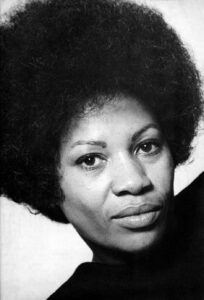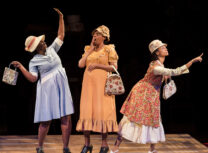Toni Morrison

Toni Morrison was born Chloe Anthony Wofford on February 18th, 1931 in Lorain, Ohio. Racial discrimination was a constant in her life from a young age, with the owner of her family’s apartment setting fire to the building with the Woffords inside after they fell behind on rent. In a 1993 interview she commented on the absurdity of this act: “If you internalized it you’d be truly and thoroughly depressed because that’s how much your life meant. For $4 a month somebody would just burn you to a crisp” (“The Laureate’s Life Song”, The Washington Post). Throughout her life, however, Toni took the circumstances she was given and turned them into opportunities for incredible creativity and insight. In elementary and middle school, she was a voracious reader, even securing a position as the secretary for the head librarian at the Lorain Public Library. At the age of twelve, she converted to Catholicism, adopting the baptismal name Anthony after Saint Anthony of Padua. This is the origin of her nickname Toni.
In 1949, Morrison began her college education at Howard University, a historically Black institution. In addition to earning a bachelor’s degree in English, Morrison met many of the artists and activists who would influence her work for years to come. She went on to get her master’s degree in English at Cornell University and began teaching at Texas Southern University shortly after. In 1957, she returned to Howard University as a professor of English and met architect Harold Morrison. The couple married and had two children, Harold and Slade, but divorced soon after in 1965.
Following her divorce and the birth of her son Slade, Morrison moved to Syracuse, New York and began editing textbooks with Random House Publishing. After two years, she transferred to the New York City division to edit fiction and works by Black authors, becoming the first Black female senior editor in the fiction department. Although Morrison had yet to publish her own works, by this point in her life she had already exerted influence over literary culture and helped to pull Black literature into the mainstream. In 1970, at the age of 39, Morrison published her first novel The Bluest Eye. In 1973, she published her second novel, Sula, which was nominated for a National Book Award in 1975. Although already well-known in literary circles, Morrison’s third book Song of Solomon launched her into the spotlight, earning a National Book Critics Circle Award as well as vast critical acclaim.
In 1983, Morrison left publishing to devote more time to writing. During this period, she wrote many novels, essays, and plays, including Beloved (1987) which won the Pulitzer Prize for Fiction and was a bestseller for 25 weeks. For her contributions to American culture and arts, Morrison was awarded the Nobel Prize in Literature in 1993, becoming the first Black woman ever to do so. She continued to accumulate accolades in the later years of her career, including the Medal of Distinguished Contribution to American Letters.
Throughout all of her writing, Morrison lifted and celebrated Black culture and identity, shining a light on systemic racism and speaking out through her works against the injustices perpetrated against Black people in America. This dedication to telling stories from historically undervalued perspectives attracted the American public, with Beloved being adapted into a feature film in 1993, the Library of Congress naming her a Living Legend in 2000, and Oprah featuring her books in Oprah’s Book Club four separate times.
In 2010, as Morrison was halfway through writing her novel Home, her son Slade, with whom she had written several children’s books, died of pancreatic cancer. When Home was published in 2012, Morrison dedicated it to Slade, who she said would have wanted her to keep writing. She continued to do so for seven more years, until she passed away from complications of pneumonia at the age of 88 on August 5, 2019. Her legacy continues to inspire readers and writers everywhere, and her dedication to the celebration of Black identity has cemented her in the fabric of culture and literature in America and around the world.
Biography adapted from the National Women’s History Museum.





